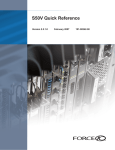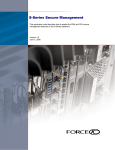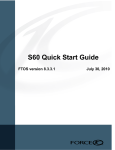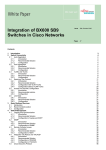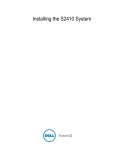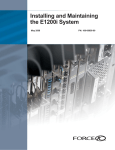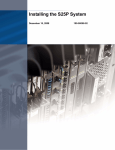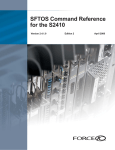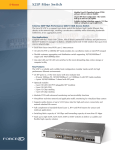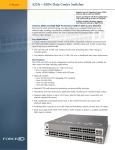Download Dell S50V System information
Transcript
S50 Quick Reference October 2005 101-00169-00 Copyright 2005 Force10 Networks All rights reserved. Printed in the USA. October 2005. Force10 Networks reserves the right to change, modify, revise this publication without notice. Trademarks Copyright 2005 by Force10 Networks, Inc. All rights reserved. Force10, the Force10 logo, E1200, E600, E300, EtherScale, FTOS, S-Series, SFTOS, and TeraScale are trademarks of Force10 Networks, Inc. All other brand and product names are registered trademarks or trademarks of their respective holders. Statement of Conditions In the interest of improving internal design, operational function, and/or reliability, Force10 Networks reserves the right to make changes to products described in this document without notice. Force10 Networks does not assume any liability that may occur due to the use or application of the product(s) described herein. Danger: To prevent electrical shock, make sure the S50 is grounded properly. If you do not ground your equipment correctly, excessive emissions may result. Use a qualified electrician to ensure the power cables meet your local electrical requirements. Warning: As with all electrical devices of this type, take all the necessary safety precautions to prevent injury when installing this system. Electrostatic discharge (ESD) damage can occur if components are mishandled. Always wear an ESD-preventive wrist or heel ground strap when handling the S50 and its components. Warning: For fan maintenance and proper ventilation, position the S50 in an equipment rack (or cabinet) with a minimum of five inches (12.7 cm) of clearance around the side intake and exhaust vents. Warning: The site where the S50 is placed should be a dry, clean, well-ventilated and temperature-controlled room, away from heat sources such as hot air vents or direct sunlight and have an environmental temperature between 32° – 122°F (0° – 40°C). Contents Overview . . . . . . . . . . . . . . . . . . . . . . . . . . . . . . . . . . . . . . . . . . . . . . . . . . . . . . . . . . . . . . . . . . . . . . . 4 Contents of the S50 CD-ROM . . . . . . . . . . . . . . . . . . . . . . . . . . . . . . . . . . . . . . . . . . . . . . . . . . . . . . . 5 Documentation . . . . . . . . . . . . . . . . . . . . . . . . . . . . . . . . . . . . . . . . . . . . . . . . . . . . . . . . . . . . . . . 5 Software . . . . . . . . . . . . . . . . . . . . . . . . . . . . . . . . . . . . . . . . . . . . . . . . . . . . . . . . . . . . . . . . . . . . 5 Training Material . . . . . . . . . . . . . . . . . . . . . . . . . . . . . . . . . . . . . . . . . . . . . . . . . . . . . . . . . . . . . . 5 Installing the Hardware . . . . . . . . . . . . . . . . . . . . . . . . . . . . . . . . . . . . . . . . . . . . . . . . . . . . . . . . . . . . 6 Insert the 10-Gigabit Module (optional) . . . . . . . . . . . . . . . . . . . . . . . . . . . . . . . . . . . . . . . . . . . . . 6 Insert the DC Power Module (optional) . . . . . . . . . . . . . . . . . . . . . . . . . . . . . . . . . . . . . . . . . . . . . 6 Attach the S50 to the Rack . . . . . . . . . . . . . . . . . . . . . . . . . . . . . . . . . . . . . . . . . . . . . . . . . . . . . . 7 Connect Stacking Ports (optional) . . . . . . . . . . . . . . . . . . . . . . . . . . . . . . . . . . . . . . . . . . . . . . . . . 8 Install Small Form-factor Pluggable (SFP) Modules . . . . . . . . . . . . . . . . . . . . . . . . . . . . . . . . . . . 8 Install XFP / CX4 Modules . . . . . . . . . . . . . . . . . . . . . . . . . . . . . . . . . . . . . . . . . . . . . . . . . . . . . . 9 Connect a Cable to the Console Port . . . . . . . . . . . . . . . . . . . . . . . . . . . . . . . . . . . . . . . . . . . . . . 9 Basic Software Configuration . . . . . . . . . . . . . . . . . . . . . . . . . . . . . . . . . . . . . . . . . . . . . . . . . . . . . . 10 Creating a User and Password . . . . . . . . . . . . . . . . . . . . . . . . . . . . . . . . . . . . . . . . . . . . . . . . . . 10 Setting the Enable Password . . . . . . . . . . . . . . . . . . . . . . . . . . . . . . . . . . . . . . . . . . . . . . . . . . . .11 Enabling Ports . . . . . . . . . . . . . . . . . . . . . . . . . . . . . . . . . . . . . . . . . . . . . . . . . . . . . . . . . . . . . . . .11 Setting the Management IP Address . . . . . . . . . . . . . . . . . . . . . . . . . . . . . . . . . . . . . . . . . . . . . .11 Enabling Telnet to the Switch . . . . . . . . . . . . . . . . . . . . . . . . . . . . . . . . . . . . . . . . . . . . . . . . . . . 12 Managing a Stack of S50 Switches . . . . . . . . . . . . . . . . . . . . . . . . . . . . . . . . . . . . . . . . . . . . . . . 12 Installing New Software . . . . . . . . . . . . . . . . . . . . . . . . . . . . . . . . . . . . . . . . . . . . . . . . . . . . . . . . 12 Enabling and Using the S50 Web Interface . . . . . . . . . . . . . . . . . . . . . . . . . . . . . . . . . . . . . . . . 12 Creating a Simple Configuration using VLANs and STP . . . . . . . . . . . . . . . . . . . . . . . . . . . . . . 13 Enabling Spanning Tree Protocol . . . . . . . . . . . . . . . . . . . . . . . . . . . . . . . . . . . . . . . . . . . . . . . . 15 Installing New Software . . . . . . . . . . . . . . . . . . . . . . . . . . . . . . . . . . . . . . . . . . . . . . . . . . . . . . . . 16 The iSupport Website . . . . . . . . . . . . . . . . . . . . . . . . . . . . . . . . . . . . . . . . . . . . . . . . . . . . . . . . . . . . 17 Notable Differences between S-Series and E-Series . . . . . . . . . . . . . . . . . . . . . . . . . . . . . . . . . . . . 18 Interface Nomenclature . . . . . . . . . . . . . . . . . . . . . . . . . . . . . . . . . . . . . . . . . . . . . . . . . . . . . . . . 18 Layer 2 Switching . . . . . . . . . . . . . . . . . . . . . . . . . . . . . . . . . . . . . . . . . . . . . . . . . . . . . . . . . . . . 19 S50 Quick Reference 3 Overview Thank you for purchasing a Force10 Networks S50 switch! This S50 Quick Reference document is printed and included in the S50 shipping box to provide you with a quick way to access basic installation and configuration instructions and to tell you how to get more information. In addition to the S50 with its SFTOS operating system (basic Layer 2 package) loaded in its default configuration, the shipping box also contains the AC power cord and a small bag with rack-mounting screws, plastic feet for table-top mounting, and the S50 Documentation and Software CD-ROM (hereafter simply referred to as the “S50 CD-ROM”). Other purchased components are shipped separately. The hardware installation section (Installing the Hardware on page 6) in this guide contains a subset of the information in Installing the S50 System, a book stored as a PDF both on the S50 CD-ROM and at the iSupport website. The software configuration section (see “Basic Software Configuration on page 10”) contains a subset of the configuration information in the SFTOS Configuration Guide, which is also on the S50 CD-ROM and at the iSupport website. In fact, all of the S50 documentation that is on the S50 CD-ROM is also available on the iSupport website. For more information about the S50 CD-ROM, see the next section, Contents of the S50 CD-ROM on page 5. For more information about the iSupport website (login required), see The iSupport Website on page 17. 4 Overview Contents of the S50 CD-ROM The S50 CD-ROM launches a Web page containing the links described in the following sections. Documentation Force10 Literature: This is a link to the Force10 Literature folder on the CD. It contains product collateral for all Force10 switches. Getting Started: This is Chapter 3 in the SFTOS Configuration Guide, available here as a standalone document for easy printing. Installing the S50 System: This book contains details of installation options. Release Notes: This document contains release notes for the SFTOS operating system. In addition to a list of open and closed caveats, the document contains a replication of the Secure Communications document listed above. It also contains a discussion of differences in the behavior between SFTOS for the S-Series (S50) and FTOS for the E-Series switches. SFTOS CLI Reference Guide: This is the SFTOS Command Reference Guide, which provides the syntax for all SFTOS commands, both the Layer-2 version of SFTOS and the extended Layer-2/Layer-3 version. SFTOS Configuration Guide: This book is designed to help you perform the most common configuration tasks, with examples of the most commonly used commands. Software Software Image: This is a link to a folder on the CD-ROM that contains the Layer-2 version of the SFTOS operating system that shipped with the system. You can check the iSupport website of Force10 for the latest image. See The iSupport Website on page 17. MIBs: This is a link to a folder on the CD containing the S-Series MIBs. Secure Communications (SSH/SSL/HTTPS): This link opens a Web page with a link to the S50 Secure Management application note, which describes how to enable secure communications through SSH, SSL, and HTTP. The Web page also contains links to folders on the CD-ROM containing example keys and shell scripts that you can use to generate your own SSH keys and SSL certificates. Training Material The Training Material link on the CD home page is to a folder on the CD-ROM containing eight sets of slides that are used in the S-Series training. The slides are presented here in PDF format. S50 Quick Reference 5 Installing the Hardware To install the S50 system, Force10 Networks recommends that you complete the installation procedures in the order presented below, before attaching a power source: • • • • Insert the 10-Gigabit Module (optional) Insert the DC Power Module (optional) Attach the S50 to the Rack Connect Stacking Ports (optional) Warning: Before starting the installation, be sure that the installation conditions conform to those specified in Installing the S50 System. Insert the 10-Gigabit Module (optional) The S50 chassis has an optional 10-Gigabit module that can be installed at the rear of the S50 chassis, as shown below. To install this component, follow the steps below: Step Task Remove the 10-Gigabit module faceplate located at the far right rear of the S50. 2. Remove the 10-Gigabit module from its packaging and slide the module into the 10-Gigabit slot. 3. Secure the captive screws on either side of the module. fn00144s50 1. Insert the DC Power Module (optional) The S50 system includes optional external power modules, connected through a cable to a power module that you install at the rear of the S50 chassis. To install these optional components, see Chapter 4 in Installing the S50 System. 6 Installing the Hardware Attach the S50 to the Rack The S50 is shipped with universal front-mounting brackets (rack ears) attached. The screws for attaching those ears to a standard 19-inch rack are in the bag that also contains the S50 CD-ROM. Ensure that there is adequate clearance surrounding the rack to permit access and airflow. If you are installing two S50 systems side-by-side, position the two S50 chassis at least 5 inches (12.7 cm) apart to permit proper airflow. Position the S50 chassis in the rack. Secure the chassis with two screws through each bracket and onto the rack post. Figure 1 Front-mounting the S50 Note: The front-mounting installation above is one of several installation options contained in the book Installing the S50 System. Other options include rear mounting, four-post mounting, and table-mounting. S50 Quick Reference 7 Connect Stacking Ports (optional) You can connect up to 8 S50 systems together to configure them to act as a unified system. Use the optional stacking cables to connect the systems through Stack Ports A and B, as depicted below. Note: The diagram shows a connection between the top and bottom S50s, from Stack Port A on unit 1 to Stack Port B on unit 3. That connection completes a topology called a ring. While that ring connection is not necessary, it provides redundancy in case of a failure of stacking cable or port. 1 2 3 fn00152s50 Stacking Port A Stacking Port B Install Small Form-factor Pluggable (SFP) Modules To install SFPs into the four open ports at the right-hand end of the S50: 1. 2. Insert the SFP into the port until it gently snaps into place. 8 fn00162s50 Position the SFP so that the bail is closed and on top of the SFP. Note: The four SFP ports shown in the graphic, when populated, automatically preempt the four copper ports labeled 45 through 48. In other words, while you use a particular optical port, you cannot use the equivalent copper port. Installing the Hardware Install XFP / CX4 Modules Warning: Do not look directly into any optical port. Failure to follow this warning could result in physical harm. To install XFPs or CX4s into the two open ports that are in the 10G module in back: 1. Position the XFP so that the bail is closed and on top of the XFP. fn00160s50 2. Insert the XFP into the port until it gently snaps into place. Connect a Cable to the Console Port Caution: Install a straight-through RJ-45 copper cable (a standard Ethernet cable) into the console port. This is different from many other implementations that require a crossover (rollover) cable. If connecting to a terminal server and using an Ethernet crossover cable, daisychain another crossover cable to effectively get a straight-through cable connection. Many console terminal servers use octopus cables that are crossover cables. As above, connect an additional crossover cable. Connect the RJ-45/DB-9 adapter that is shipped with the S50 system to the RJ-45 cable. Set your console terminal settings to: Note: The console port pinout: fn00162s50 Pin 1 = NC Pin 2 = NC Pin 3 = RXD Pin 4 = GND Pin 5 = GND Pin 6 = TXD Pin 7 = NC Pin 8 = NC • • • • • 9600 baud rate no parity 8 data bits 1 stop bit no flow control See the Getting Started chapter of the SFTOS Configuration Guide for other console port details, such as setting the console timeout and changing the baud rate. S50 Quick Reference 9 Basic Software Configuration This Quick Reference contains a small subset of the information that is provided in the Getting Started chapter of the SFTOS Configuration Guide. That guide is available as a PDF on the S50 CD-ROM and on the Documents tab of the iSupport website. The Getting Started chapter is also available on the CD-ROM as a separate PDF file. This section discusses the following configuration topics for the S50: • • • • • • • • • • Creating a User and Password on page 10 Setting the Enable Password on page 11 Enabling Ports on page 11 Setting the Management IP Address on page 11 Enabling Telnet to the Switch on page 12 Managing a Stack of S50 Switches on page 12 Installing New Software on page 12 Enabling and Using the S50 Web Interface on page 13 Creating a Simple Configuration using VLANs and STP on page 14 Enabling Spanning Tree Protocol on page 15 Creating a User and Password The S50 comes installed with one read/write user named “admin”, with no password. You can add that password, and also create up to five more read/write users with the username command in Global Config mode. The command edits the user name and password in one statement, as shown below. Usernames provide access to the S50 through both the CLI and the Web interface. Note: Text boxes surrounded by oval lines, such as the following, are used throughout Force10 documentation to simulate the appearance of a terminal screen after logging in to the operating system of the switch through a console program. The hostname prompt, exemplified in the following example by “(Force10_S50)”, is configurable. Note: In this guide, bold text highlights the commands that you enter. : (Force10_S50) >enable (Force10_S50) #config (Force10_S50) (Config)#username admin passwd apassword User login name and password are set. (Force10_S50) (Config)#exit (Force10_S50) #exit (Force10_S50) > 10 Basic Software Configuration Setting the Enable Password The Privileged Exec password (commonly called the “enable” password), is not set when the S50 starts the first time. To set the enable password, access the Privileged Exec mode (also called “enable mode”), as shown in the following example. (Also note you do not use the Global Config mode here.) Enter the command enable passwd, then press Enter. At the prompts, enter the password that you want to use: : (Force10_S50) >enable (Force10_S50) #enable passwd Enter new password:******* Confirm new password:******* Password Changed! (Force10_S50) #exit Enabling Ports When the S50 is first installed, all ports are disabled by default. To enable all ports, enter no shutdown all in Global Config mode, as shown here: (Force10_S50) (Force10_S50) (Force10_S50) (Force10_S50) >enable #config (Config)#no shutdown all (Config)#exit Alternatively, you can use the no shutdown command at the specific interface level. Note: The equivalent action on the Web interface is to select Enable in the Admin Mode field of the Port Configuration panel. See Enabling and Using the S50 Web Interface, next. Setting the Management IP Address Continuing in Privileged Exec mode (the “#” prompt is also called “enable” mode) (Note: Do not use Global Config mode here), use the network parms command to set the management IP address of the switch and the gateway. You can use that IP address to manage the switch through the Web interface of the switch. The addresses in the following example show only the format; you enter your own IP addresses. (Force10_S50) #network parms 172.17.1.33 255.255.255.0 172.17.1.254 IP Address of the Switch (sample) Mask Default Gateway Note: This management address is reachable from VLAN 1. All physical ports are, by default, members of VLAN 1, so the management address will be reachable from all enabled physical ports by default. S50 Quick Reference 11 Enabling Telnet to the Switch Access to the switch through a Telnet server is disabled by default. If you want to access the switch through an SSH client, you would leave Telnet disabled and set up the SSH connection, as described in “Enabling Secure Management with Secure Shell or Secure Sockets Layer” in the SFTOS Configuration Guide. To enable Telnet access, execute the ip telnet server enable command. Managing a Stack of S50 Switches When you connect a set of previously unconfigured S50 switches, and you follow the instructions in Connect Stacking Ports (optional) on page 8, a startup algorithm automatically designates a unit to be the management unit. You do not need to configure anything else specific to stack management. If, on the other hand, you are modifying a stack, you will need to follow the directions that are in the Stacking chapter of the SFTOS Configuration Guide. If you need to upgrade the software in the stack, see the following section. Installing New Software The S50 comes with the basic Layer-2 software package installed. If you purchased the extended Layer-3 software package, you will receive instructions under separate cover on how to access the software. If you need to upgrade the software image that is installed on the S50, and you want to download the image from a TFTP server, issue the following command: copy tftp://ip address/filename system:image You can use variations of the copy command to download the software image or the startup configuration to the switch. For details on the command syntax, see the copy command in the SFTOS Command Reference Guide. More detailed instructions for upgrading or reinstalling the software or configuration files are available in the Getting Started chapter of the SFTOS Configuration Guide. 12 Basic Software Configuration Enabling and Using the S50 Web Interface The Web interface to the S50 that is provided by the SFTOS operating system provides much of the functionality provided by the CLI. Also, the CLI and Web interface can be used in combination to give you even better control. 1. To enable the Web interface, you first must give the S50 a management IP address, which you can using the network parms command, as described above. 2. Then, continuing in Privileged Exec mode, enter the command ip http server. Note: Details on enabling an HTTPS secure server are in Chapter 7, “Security”, the SFTOS Configuration Guide and through a separate link on the S50 CD-ROM. 3. Launch a supported Web browser. The Web browser must support: • HTML version 4.0, or later • HTTP version 1.1, or later • JavaScript(TM) version 1.2, or later 4. Enter the URL of the switch (http://<IP address>) in the Web browser address field. The IP address is the management IP address that you assigned above. 5. When the Login panel is displayed, click the Login button. 6. Enter the admin username and password, or any other username and password that you created, as discussed above in Creating a User and Password. 7. The Navigation tree is displayed in the left frame, and the System Description panel is displayed in the right frame. Make your selection by clicking on the appropriate item in the Navigation tree. For example, the following screenshot shows that the Inventory Information panel opened when the user clicked the Inventory Information node in the tree. Notice that the Inventory Information panel displays the serial number of the S50. Notice also the large red Help button, which displays on every panel, and provides context help for the panels in the selected branch of the tree. S50 Quick Reference 13 Creating a Simple Configuration using VLANs and STP You can use the S50 Web interface to create a VLAN. The following screenshot of the VLAN Configuration panel shows selection of a group of ports to add to a VLAN. 1. Access the VLAN Configuration panel by traversing the Navigation tree in this sequence: System >> Switching >> VLAN >> Configuration 2. On the VLAN Configuration panel, simply choose the VLAN number, and assign a name if you desire. 3. Then choose the interfaces that you want to include in the VLAN, and whether you want them to participate in tagged or untagged mode. 4. When you have finished, click the Submit button at the bottom of the panel. If you have questions about VLAN configuration, click the red Help icon in the upper right corner of the panel. Note: As noted in Enabling Ports on page 11, all ports are disabled by default. Enable them with no shutdown all (Global Config mode), or individually with the no shutdown command on each port. The equivalent action on the Web interface is to select Enable in the Admin Mode field on the Port Configuration panel. 14 Basic Software Configuration If you prefer to use the command line interface (CLI) for the same purpose, here is an example of using the CLI to create a VLAN (55) and add an interface to it: : (Force10_S50) (Force10_S50) (Force10_S50) (Force10_S50) (Force10_S50) (Force10_S50) (Force10_S50) (Force10_S50) (Force10_S50) #vlan database (Vlan)#vlan 55 (Vlan)#exit #configure (Config)#interface 1/0/5 (Interface 1/0/5)#vlan participation include 55 (Interface 1/0/5)#vlan pvid 55 (Interface 1/0/5)#vlan tagging 55 (Interface 1/0/5)#vlan participation exclude 1 In the above example, we have also excluded the port from VLAN 1 (all ports are included by default). We have also set the Per VLAN ID (PVID) to 55. This causes untagged frames to be assigned to VLAN 55. vlan tagging 55 causes frames transmitted by this port to be tagged as part of traffic for VLAN 55. These additional functions are found on other screens in the Web interface, and their Help screens can assist you in configuring them. For more on using the CLI to create VLANs, see the IEEE 802.1Q VLANs chapter in the SFTOS Configuration Guide. Enabling Spanning Tree Protocol Spanning Tree Protocol (STP) is off by default. First, you must enable STP globally. To use the Web interface to enable it, navigate to the Spanning Tree branch, and then select the Switch Configuration/ Status panel: S50 Quick Reference 15 Next, enable STP on the desired ports. To use the Web interface, select the CST Port Configuration/ Status panel. Choose the port from the Unit/Slot/Port list, and then set Port Mode to Enable: Alternatively, you can use the CLI to enable STP. It is possible to enable spanning tree globally, and on all the ports with just two commands: (Force10 (Force10 (Force10 (Force10 (Force10 S50) S50) S50) S50) S50) #configure (Config)#spanning-tree (Config)#spanning-tree port mode all (Config)#exit #show spanning-tree summary Spanning Tree Adminmode........... Spanning Tree Version............. Configuration Name................ Configuration Revision Level...... Configuration Digest Key.......... 0xac36177f50283cd4b83821d8ab26de62 Configuration Format Selector..... No MST instances to display. Enabled IEEE 802.1s 00-01-E8-D5-A0-F7 0 0 (Force10 S50) #show spanning-tree interface 1/0/1 Hello Time..................................... 0 Port Mode...................................... Enabled Port Up Time Since Counters Last Cleared....... 0 day 0 hr 19 min 38 sec STP BPDUs Transmitted.......................... 2 STP BPDUs Received............................. 593 RSTP BPDUs Transmitted......................... 0 RSTP BPDUs Received............................ 0 16 Basic Software Configuration The iSupport Website You must first request a password to access the iSupport website. 1. On the Force10 Networks website home page, www.force10networks.com, click the Support link. 2. Click the Account Request link. 3. Fill out the User Account Request form and click Send. 4. Click Login, and then enter the userid and password that you received by email. The i-Support website (www.force10networks.com/support/) contains the following five tabs: • • • • • Home: Summary of open cases, RMA management, and field notices (as shown below) Service Request: Case management Software Center: Software downloads, bug fixes, and bug tracking tool Documents: User documentation, FAQs, field notices, technical tips, and white papers Support Programs: Information on the complete suite of Force10 support and professional support services. For more on using the iSupport website and accessing services, see the Force10 Service and Support Guide, available on the Home tab, as displayed above. You can also contact the Force10 Technical Assistance Center (TAC) by: • E-mail: [email protected] • Telephone: — US and Canada customers: 866-965-5800 — International customers: 408-965-5800 S50 Quick Reference 17 Notable Differences between S-Series and E-Series This section describes the major differences in how command usage on the S-Series differs from the E-Series. Users familiar with the E-Series CLI will notice enough similarities in the CLI environment on the S-Series that they can quickly learn the variations in syntax and usage. Of course, there are more commands with more detailed options in FTOS than in SFTOS, because FTOS supports the E-Series switches, which are larger and more complex than the S50 (currently, the only switch in the S-Series line, supported by SFTOS). Interface Nomenclature The major difference between SFTOS and FTOS is that commands that contain a parameter in the form slot/port in FTOS use a unit/slot/port parameter in SFTOS for both physical and logical interfaces. For physical identifiers, the unit is the stack member number in an S50 stack. For example, both FTOS and SFTOS have the show interface command, but the SFTOS equivalent of show interface gigabitethernet 2/11 (slot 2, port 11 in FTOS) would be show interface 1/0/11, where 1/0/11 represents unit 1 in the stack, slot 0, port 11. If the port were in unit 2 of the S50 stack, the command would be show interface 2/0/11. Logical interface identifiers are automatically generated by SFTOS. They also use the unit/slot/port convention, but system unit numbers are always 0, slot numbers are sequential, starting at 1, and the interface numbers (in the third position) are also sequential, starting at 1 per slot. Other variations include: • Creating a static route: The SFTOS command ip route supports only IP addresses for setting the next-hop router, while ip route in the FTOS also supports physical interfaces. • Setting the size of the logging buffer: The FTOS command logging buffered has a parameter that enables you to set the size of the buffer, while SFTOS does not. Both FTOS and SFTOS invoke debug logging with the number 7 for the severity level parameter. The SFTOS command is logging buffered 7. Displaying the MAC address table: Both FTOS and SFTOS have the show mac-address-table command, but the SFTOS command show mac-addr-table provides more similar results to that FTOS command. The SFTOS syntax contains the unit/slot/port form cited above, for example, • show mac-addr-table interface 1/0/4. • Displaying system information: The FTOS command show linecard is similar to show version in SFTOS, which shows basic information, including the running software version and up time. Other similar commands in SFTOS are show hardware and show sysinfo, and show tech-support provides the results of a group of those similar commands. • terminal length: This FTOS command (often shortened to “term len”) is not available in SFTOS. • SFTOS sets the number of lines displayed on the terminal screen as a function of each report, to optimize its presentation. service timestamps: This FTOS command is not available in SFTOS. SFTOS sets timestamps automatically. aaa authentication: This FTOS command is available in SFTOS as authentication. • 18 Notable Differences between S-Series and E-Series Layer 2 Switching There are differences in the VLAN switching behavior between S-Series (S50) and E-Series. The differences are summarized in the following table. S50 E-Series An untagged port can be a member of many VLANs. An untagged port can be a member of only one VLAN. A port can be tagged in one VLAN and untagged in another VLAN. If a port is a member of multiple VLANs, it must be tagged. A port is a member of VLAN 1 until explicitly excluded. When a port is assigned a VLAN, the port is implicitly excluded from VLAN 1 (the default VLAN). A port forwards traffic in VLAN 1 even when assigned a VLAN, until configured with the vlan pvid command. When a port is assigned a VLAN, all traffic on the port is forwarded in that VLAN. Untagged traffic is forwarded in the VLAN configured with the vlan pvid command. To accept only tagged frames on the port, use the vlan acceptframe vlanonly command. Untagged traffic is dropped when it is received on a port that is configured as a tagged port. The following table displays how to configure tagged and untagged ports on the S50 so that they behave the same way as on the E-Series. S50 E-Series To configure a tagged port for VLANs 10 and 11 on port 1/ 0/1: (S50)(Config)#interface 1/0/1 ! Only accept tagged frames (S50)(Interface 1/0/1)#vlan acceptframe vlanonly ! Exclude VLAN 1 (S50)(Interface 1/0/1)#vlan participation exclude 1 ! Include VLAN 10 (S50)(Interface 1/0/1)#vlan participation include 10 ! Transmit tagged frames for VLAN 10 (S50)(Interface 1/0/1)#vlan tagging 10 ! Include VLAN 11 (S50)(Interface 1/0/1)#vlan participation include 11 ! Transmit tagged frames for VLAN 11 (S50) (Interface 1/0/1)#vlan tagging 11 To configure a tagged port for VLANs 10 and 11 on port g0/1: Force10(conf)#interface g0/1 Force10(conf-if-gi-0/1)#switchport Force10(conf-if-gi-0/1)#interface vlan 10 Force10(conf-if-vl-10)#tagged g0/1 Force10(conf-if-gi-0/1)#interface vlan 11 Force10(conf-if-vl-11)#tagged g0/1 To configure an untagged port for VLAN 10 on port 1/0/1: (S50) (Config)#interface 1/0/1 ! Only forward traffic in configured VLANs ! Set the VLAN ID to 10 (S50) (Interface 1/0/1)#vlan pvid 10 ! Exclude VLAN 1 (S50) (Interface 1/0/1)#vlan participation exclude 1 ! Include VLAN 10 (S50) (Interface 1/0/1)#vlan participation include 10 S50 Quick Reference To configure an untagged port for VLAN 10 on port g0/1: Force10(conf)#interface g0/1 Force10(conf-if-gi-0/1)#switchport Force10(conf-if-gi-0/1)#interface vlan 10 Force10(conf-if-vl-10)#untagged g0/1 19 20 Notable Differences between S-Series and E-Series




















